Enthusiasm must not overshadow proper informed consent for LASIK
SAN ANTONIO, Texas — "Optometrists may unwittingly miscommunicate that laser in situ keratomileusis (LASIK) is perfect," said Arthur A. Medina Jr., OD.
"One of my biggest concerns about LASIK is the enthusiasm of the primary care optometrist about the success of LASIK and how we’ve minimized the complications. I go to great lengths to explain that every refractive surgery is still surgery, and no surgery is perfect," he added. Dr. Medina participates with 25 other optometrists and a group of surgical ophthalmologists in total management of the refractive surgery patient.
Preop considerations
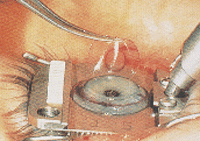 ---Intraoperatively: The corneal flap can be lifted with non-toothed forceps.
---Intraoperatively: The corneal flap can be lifted with non-toothed forceps.
Dr. Medina explains that everyone in his group uses the same protocol, which includes a detailed contact lens and medical history in the form of a checklist. Slit lamp evaluation includes a careful assessment of the tear film using rose bengal stain, Schirmer’s testing and tear break-up time.
Any dry eye conditions are pre-treated with artificial tears and either collagen or silicone plugs. Basement membrane disease is specifically ruled out. Uncorrected as well as corrected visual acuities, keratometry readings, a maximum plus manifest refraction, a cycloplegic refraction and the slit lamp examination are all recorded and sent with the patient for a pre-surgical interview.
The optometrist and the patient have already discussed the most appropriate form of refractive surgery with the caveat that pachymetry and topography measurements must still be taken and may dictate a change in surgical choice. At this interview, the surgeon has the opportunity to verify any information necessary.
"We give the patient the option to have unilateral or bilateral surgery," Dr. Medina said. "We started off unilateral, and then developed a comfort level with bilateral. And we use the disclaimer that after the first eye is done, we reserve the right to stop and not do the second eye."
Day of surgery
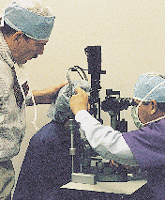 ---Immediately postoperatively: Dr. Medina examines the position of the flap immediately after LASIK, with Robert Snip, MD, looking on.
---Immediately postoperatively: Dr. Medina examines the position of the flap immediately after LASIK, with Robert Snip, MD, looking on.
In Dr. Medina’s group, the primary optometrist also assists in surgery much like the cardiologist who works with the cardiovascular surgeon.
"While the surgeon concentrates on the procedure, we concentrate on making the patient comfortable and reassured. It’s our voice the patient hears during the procedure," he explained.
After surgery, the optometrist performs a slit lamp evaluation. The information gained by being present during surgery and that first immediate slit lamp exam is invaluable as a guide to what the optometrist can expect to see in the first follow-up the next morning.
"Cap management immediately postop is a crucial component," Dr. Medina added. "One little trick we have is a lid speculum with ports that aspirate while the surgeon is irrigating."
After the surgery, a clear shield is placed over the eye to be worn for the first full day and at night for the following 5 nights. Patients are cautioned to "be very, very careful about being around small animals and small children. Do not rub the eye," said Dr. Medina. Additionally, the patient may not wear make-up for 4 days, and swimming is not permitted for 2 weeks.
Dr. Medina likes to call each patient the night of the surgery as well, a personal touch he finds very rewarding. "This lets them know that we care for them, and it reassures them," he said. Dr. Medina said every patient comes back in the morning saying, , it was nice that you called last night."
First day postop
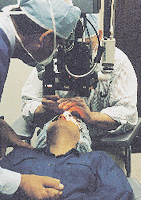 ---Team approach: Dr. Medina assists the surgeon and reassures the patient throughout the procedure.
---Team approach: Dr. Medina assists the surgeon and reassures the patient throughout the procedure.
The first morning postoperatively, the patient is seen in the optometrist’s office. Dr. Medina does not allow his staff to take preliminary acuities, as he likes to personally bring patients down the chart slowly with both eyes open to reassure them.
The biggest mistake he has seen is covering the left eye and asking the patient to look at the chart with an eye that was targeted to be for near vision. At this first visit, refractive measurement is two-fold, spherical manifest first, then spherocylindrical manifest. Tonometry is not performed.
Slit lamp examination may reveal some corneal inflammation, some re-epithelialization at the incision site or some striae at the site of the hinge. The eye usually appears white and quiet. Occasionally a very small subconjunctival hemorrhage from the microkeratome track and suction will occur. The check for cells and flare is usually negative. The patient will be started on a tobramycin-dexamethasone combination four times a day for 4 days.
The optometrist calls the surgeon if there are significant striae at the hinge, obvious debris under the flap, epithelial ingrowth under the cap or if the acuity is not in the anticipated range. Information is faxed to the surgeon. If there are any abnormalities, the surgeon is called.
The surgeon and optometrist decide together how to treat any difficulties. Minor epithelial ingrowth may be monitored, or the surgeon may elect to lift the flap and irrigate.
A sign of very serious concern is the so-called "Sands of the Sahara" — a swirling, undulation effect of the cornea under the cap seen with high magnification and retroillumination. This rare complication of controversial etiology requires intensive antibiotic and anti-inflammatory management by the surgeon and optometrist.
Sands of the Sahara tends to eventually recover on its own, but "no one has the guts not to treat it," Dr. Medina said.
Extended postop
At 1-week postoperatively, re-epithelialization should be complete, no striae should remain and the correctable vision should be equal to preoperative vision with a refraction that is within 0.50 D of the targeted prescription. Again, the cornea is carefully surveyed for epithelial ingrowth or Sands of the Sahara.
"Typically, flap defects are going to show up within the first day to first week. If you find something after the first day, it is typically mechanically induced," Dr. Medina said.
"At the 1-month visit, the patient should be very close to the targeted visual acuity. If we’re not, we should start preparing the patient for enhancement. We won’t perform it until after the second month, but we want the patient to be prepared," he said.
Some small islands may appear in the higher myopes, but they have usually disappeared between the 1-week visit and the 1-month visit. At the 2-month visit, Dr. Medina said, "It’s usually just hugs and kisses," and the happy patient is released until the next yearly visit.
At this time, a decision will have to be made regarding enhancement for those whose acuity did not reach the target. Also, Goldmann tonometry is done for the first time following surgery for most patients.
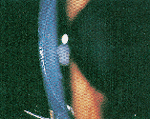 Two hours later: A gap between the flap and stromal bed can be seen when viewing the keratectomy incision 2 hours postop. | 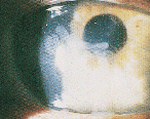 Six months later: Epithelialization should have occurred under the interface by 6 months postop if it is going to occur. |
For Your Information:
- Arthur A. Medina Jr., OD, may be reached at 1110 McCullough, San Antonio, TX 78212; (210) 225-4141; fax: (210) 229-9400; e-mail: Artmedina@aol.com. Dr. Medina has no direct financial interest in the products mentioned in this article, nor is he a paid consultant for any companies mentioned.
